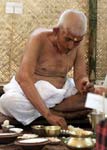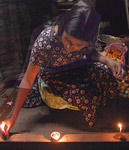 |
|
|
|
|
|
 |
| Nepal's Festivals |
| Festivals July to December |
 |
| July
August |
GAIJATRA | In this festival teen-aged boys dressed up in the attire of a cow parade in the streets of the town. This custom spring from the belief that cows help the members of the family, who have died within that year, to travel to heaven smoothly. Some are also dressed up as an ascetic or a fool for achieving the same objective to their dead family members. Groups of mimics improvise short satirical enactments on the current sociopolitical scenes of the town to the entertainment of the public. The week beginning from Janai Poornima actually unfolds a season of good many religious and cultural activities. All the Buddhist monasteries open their gates to the visitors to view their bronze sculptures and collection of painting for a week. At Patan, one observes the festival of Mataya at this time. The festivity of Gaijatra itself lasts for a week enlivened by the performance of dance and drama in the different localities of the town. The spirit of the old festival is being increasingly adapted by Cultural Centres, newspapers and magazines of fling humour and satire on the Nepalese social and political life. | ||
| July
August |
GURU PURNIMA | The festival of Guru Purnima was being observed throughout Nepaly, with expressions of devotion and respect to the teachers. The tradition dating back to the vedic period of expressing gratitude to the teachers imparting education, making disciples aware of their duty, and showing the path for the future is found to be equally important even today. The sage Veda Byas divided the veda scriptures in four parts, authored 18 puranas, the Mahabharat, Gita and other books and provided inspiration to guide the world from darkness to light, from falsehood to truth and mortality to immortality. His birthday is observed as Guru Purnima. | ||
| July
August |
DUMJI | It is celebrated in all the Sherpa settlements in the month 6f July. The Sherpas of Khumbu and Helambu regions participate in dancing on this day. | ||
| July
August |
PANCHA DAN | This is a Buddhist festival in which gifts are made by the laity to the monks. Since monastic Buddhism has been long extinct in Nepal, the receivers of the gift today are the Buddhist priests, the Sakyas and the Vajracharyas, who go begging aims to the house of their clients. Mainly food grains are offered on this occasion to the begging priests. Traditional collections of artifacts are displayed in monasteries and households on this occasion. | ||
| July
August |
JANAI POORNIMA | The
full-moon of the month of Shrawan, the day when this festival is observed,
is considered sacred ail over Nepal and is celebrated in different manner
by different groups of people of Nepal. However,
the most widely accepted mode of celebration is that on this day people take a ritual bath and change their sacred thread. Everyone gets a string of thread tied in his wrist from the Brahmans as a protective mark for the whole year. The Nepalese prepare a special dish called 'Kwati, (mixed sprouted beans) on this day. This day is also held sacred for bathing in Gosainkunda. One can also see witch doctors attired in their traditional costume come to bathe at Kumbheshwor at Patan. These Jhankris also visit the temple of Kaiinchowk Bhagavati (the goddess at Kalinchowk) in Dolkha district where they go to beg for their healing powers, as they are the traditional healers of the Nepalese villagers. |
||
| July
August |
NAGA PANCHAMI | This is devoted to the worship of the Nagas, the divine serpents. Pictures of the Naga are stuck over the doorposts of all the houses in the morning as protective spells. This is also the day for the beginning of Gunialakhe dance in Kathmandu in which persons wearing masks of a demon entertain the people with their gimmick. | ||
| August | INDRA
JATRA
|
The festival of Indra, the rain god, is observed in the city of Kathmandu with great enthusiasm. The festival is celebrated in August-September lasting for eight days. The chariot of Kumari, the Living Goddess, is taken out in processing through the main streets of Kathmandu three times within eight days. The Kumari is placed on a decorated chariot which is pulled which through the street by devotees. The whole celebration is largely confined to the traditional market and residential areas of Kathmandu, particularly the Durbar Square, of the Hanuman Dhoka, which echoes to the beating of drums and dancing feet of the masked dancers almost every evening. | ||
| August | GORKNA AUSNI | This day is observed as the Father's Day with the expression of proper regards towards one's father. It is individually performed by persons out of filial piety. Those whose fathers are already dead go to bathe and perform shraddha ceremony in honour of their dead fathers at Gokarna. The fortunate ones whose fathers are alive present him with gifts of sweetmeat and delectable food and drink and receive blessings in return from them. Government offices are closed on this day. | ||
| October | DASHAIN
or
DURGA PUJA |
The
Durga Puja festival is the most important festival of the entire Nepalese.
The entire country is en tete at the time of this festival. It takes place
some time in the month of October and is observed as a national holiday
lasting as long as 15 days in the case of educational institutions.
|
||
| October | TIHAR
|
This is known as the festival of lights. It is celebrated for five days in October-November. Houses are illuminated at night and the special food prepared for this occasion consists of sweets of diverse kinds. The first two days are dedicated to the crow and the dog respectively while the third, fourth and fifth days are dedicated to cow, ox and brothers respectively. | ||
| December | SHRI
PANCH
KO JANMA DIVAS |
This is the birthday celebration of His Majesty King Birendra Bir Bikram Shah Dev. This occasion is celebrated with great enthusiasm all over the kingdom. It falls on December 28. One of the highlights of the occasion is the mammoth parade held at Tundikhel to pay loyal tribute to His Majesty. | ||
| December | MAHENDRA
JAYANTI
and CONSTITUTION DAY |
It generally falls on December 15. On this day in 1960 the Late King Mahendra replaced the party system of government by the Party less Panchayat system of democracy. The day is observed by bringing out a mammoth parade and illumination. | ||
| December | ||||
| December | GAI
JATRA
(COW FESTIVAL) |
It is a carnival type of festival lasting eight days. Dancing, singing, comedy and anything that cause mirth and laughter are its highlights. Those people whose family members have died during the year send out persons dressed up as cows to parade the main through fares of the city on the first day of the festival. | ||
| December | GHODE JATRA | This festival is known as the festival of horses. It is one of the cultural festivals of the Kathmandu city. Horse race and other sports take place at Tundikhel on this day. In other parts of the city the various deities are carried shoulder high on wheeless chariots, (khat) with the accompaniment of traditional music. | ||
| December | KRISHNASTAMI | It marks the birthday of Lord Krishna, one of the incarnations of Vishnu and epic hero of the Mahabharata. On this day, there is an impressive ceremony at the Krishna temples in Patan and Changu Narayan, Folk dances and songs are usual on this occasion. | ||
| December | MACHHEDNRA JATRA | It signifies a festival in honour of the White Machhendranath of Kel Tole in Kathmandu. A long chariot carrying the divinity is pushed across the city. | ||
| December | VIVAHA PANCHAMI | This is a famous festival of Janakpur in Dhanusha district in the eastern Terai, The occasion commemorates the marriage of Sita to Ram, one of the most venerated Hindu divinities. It attracts thousands of pilgrims from India. The festival takes place in the streets of old Kathmandu for several days. |
 |
 |
 |
 |
 |